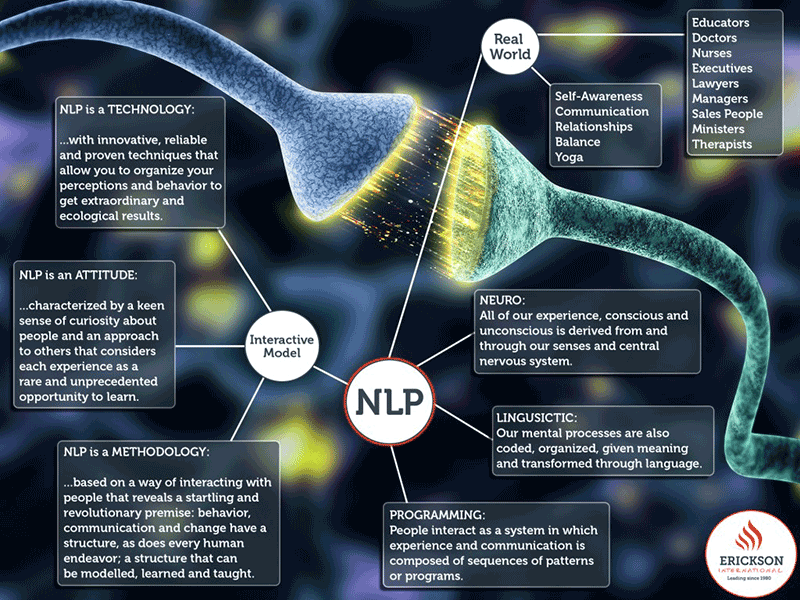Featured image from: Erickson Coaching International
What if there was a way to get past deep-seated trauma, improve how you react to situations, and become a better person in general, all by just changing the way we use words?
Well, NLP has the key. With NLP, people are given the power to choose the way events affect them by changing the way we use words. How does it work?
What is Neuro-linguistic Programming, or NLP?
Neuro-linguistic Programming, or NLP, is a branch of communication and psychotherapeutic studies that approaches wellness and personal development by analyzing the link between language and neurological processes.
Initially created by Richard Bandler and John Grinder, NLP is able to “correct” or treat problems such as phobias, psychosomatic illnesses, and other behavioral disorders through a series of mental and linguistic exercises:
Dissociation:
 Negative emotions such as depression, anger, stress, and the like are usually the result of trigger reactions to everyday experiences. These emotions can manifest in various ways, such as feeling a sense of irrational anger when someone mentions a specific phrase or word, or an unwanted habit by a friend or partner.
Negative emotions such as depression, anger, stress, and the like are usually the result of trigger reactions to everyday experiences. These emotions can manifest in various ways, such as feeling a sense of irrational anger when someone mentions a specific phrase or word, or an unwanted habit by a friend or partner.
By using the Dissociation method, a person can effectively cut the connection between that trigger word/event and a negative emotion. It’s an essential and long-lasting treatment method for people with deep-seated psychological issues like depression, anxiety, and phobias. Dissociation gives you a positive and healthy way of dealing with trigger events in your daily life, whether it’s at home, work, or in your personal relationships.
Anchoring:
Slightly similar to Dissociation but aimed at the exact opposite, the concept of Anchoring is to create a persistently positive emotional response to a particular trigger word/event, or even physical stimuli. This can be done by directly linking these triggers with a positive emotion, like touching a person’s shoulder every time they laugh. This simple act can create a psychological link between your shoulder touch and their laughter, thus “anchoring” that trigger to a positive feeling.
Anchoring is a very powerful and effective way of directly affecting the way a person feels and is often used by therapists to put patients at ease. It can also be used on the self: by anchoring a word to a particular positive emotion, you can create personalized and instant pick-me-ups that will help you when you feel down.
Rapport:
 Rapport is more than just the art of good conversation: it’s a way for people to empathize with the people around them and helps people learn valuable skills like listening, recognizing body language, tact, among other things. Rapport is one of NLP’s most accessible techniques and is perhaps one of the most important skills in terms of teaching a person how to be a better social being.
Rapport is more than just the art of good conversation: it’s a way for people to empathize with the people around them and helps people learn valuable skills like listening, recognizing body language, tact, among other things. Rapport is one of NLP’s most accessible techniques and is perhaps one of the most important skills in terms of teaching a person how to be a better social being.
Sociability not only helps you build conversational skills, it also helps you live longer and feel happier.
Belief Change:
In order for humans to make sense of the world around us, we create a series of complex and complicated belief systems that shape our opinions and assumptions, and influences our day-to-day lives. While some of these beliefs are inherited from our society, some beliefs are created by our own idiosyncrasies and nuances. When a person is faced with a trigger event that challenges our belief system, we can sometimes find ourselves in a fit of defensive anger, depression, or inexplicable anxiety.
While a Belief Change is one of the most difficult NLP exercises out there, it is also one of the most powerful. Changing your Belief System can have long-lasting repercussions in a person’s psyche, which can possibly eradicate negative behavior and create positive habits.
Content Reframe:
A more advanced NLP technique, Content Reframe is a visualization exercise that helps people “reframe” the way they see a disempowering or victimizing situation. Through a series of mental exercises, a person can view negative situations or triggers in a way that helps them see positive outcomes in an otherwise hopeless event.
 Content Reframing is of great benefit to people who suffer from severe trauma, such as PTSD, sexual assault, or abuse during childhood. It can even be used to placate and improve the moods of those suffering from terminal or chronic conditions. Content Reframing can also be used to deal with sudden traumas, such as an unexpected death or loss of employment. This technique helps you stay afloat until you get through hard times.
Content Reframing is of great benefit to people who suffer from severe trauma, such as PTSD, sexual assault, or abuse during childhood. It can even be used to placate and improve the moods of those suffering from terminal or chronic conditions. Content Reframing can also be used to deal with sudden traumas, such as an unexpected death or loss of employment. This technique helps you stay afloat until you get through hard times.
By empowering people to narrate their own lives, NLP helps people master their emotions and become happier people in general. NLP allows people to improve themselves simply and effectively, all by adjusting the way they connect words with emotions and events. In this way, not only are you improving yourself, you’re also improving the way you react to situations, people, and words, and thus improving the world as a whole.

